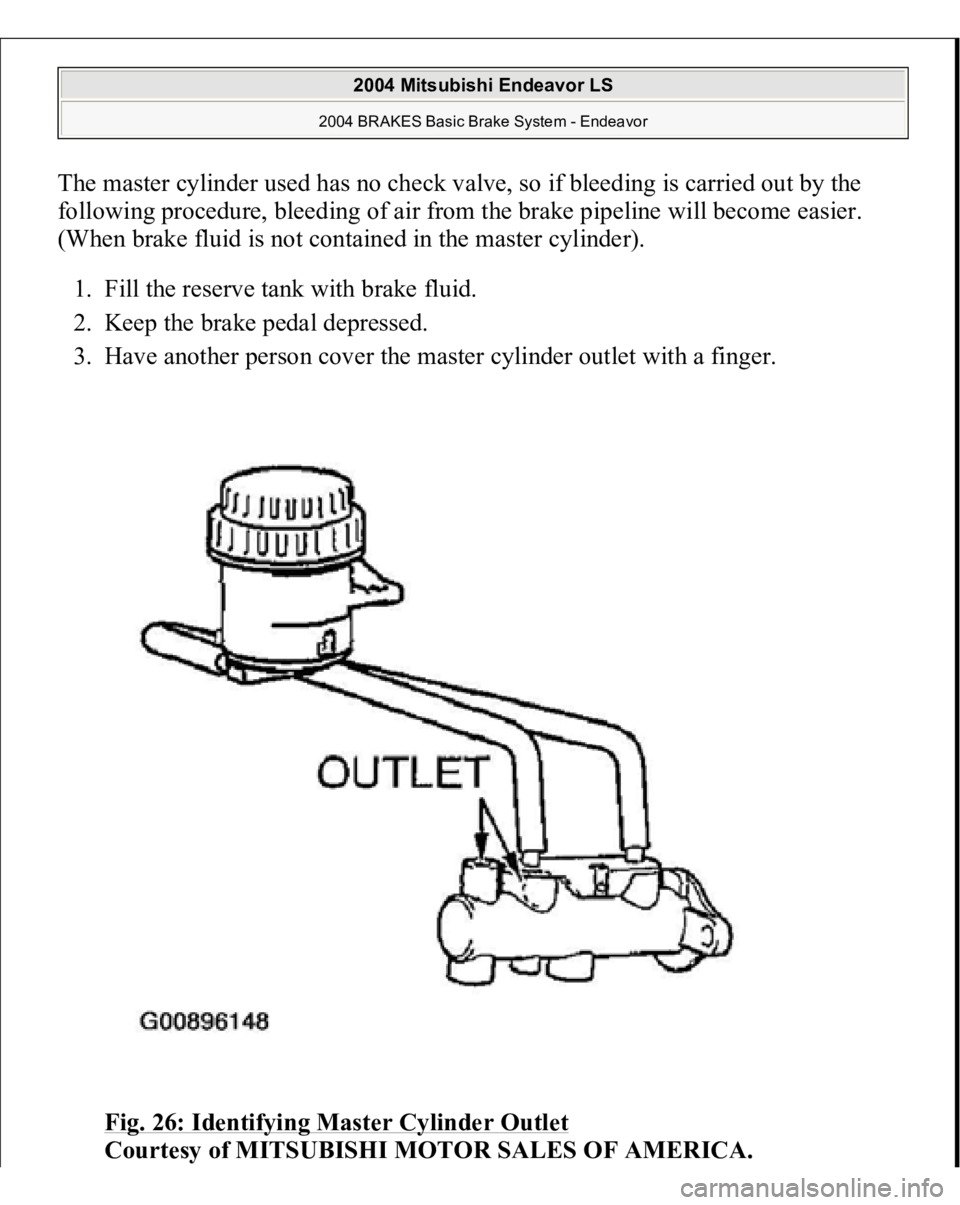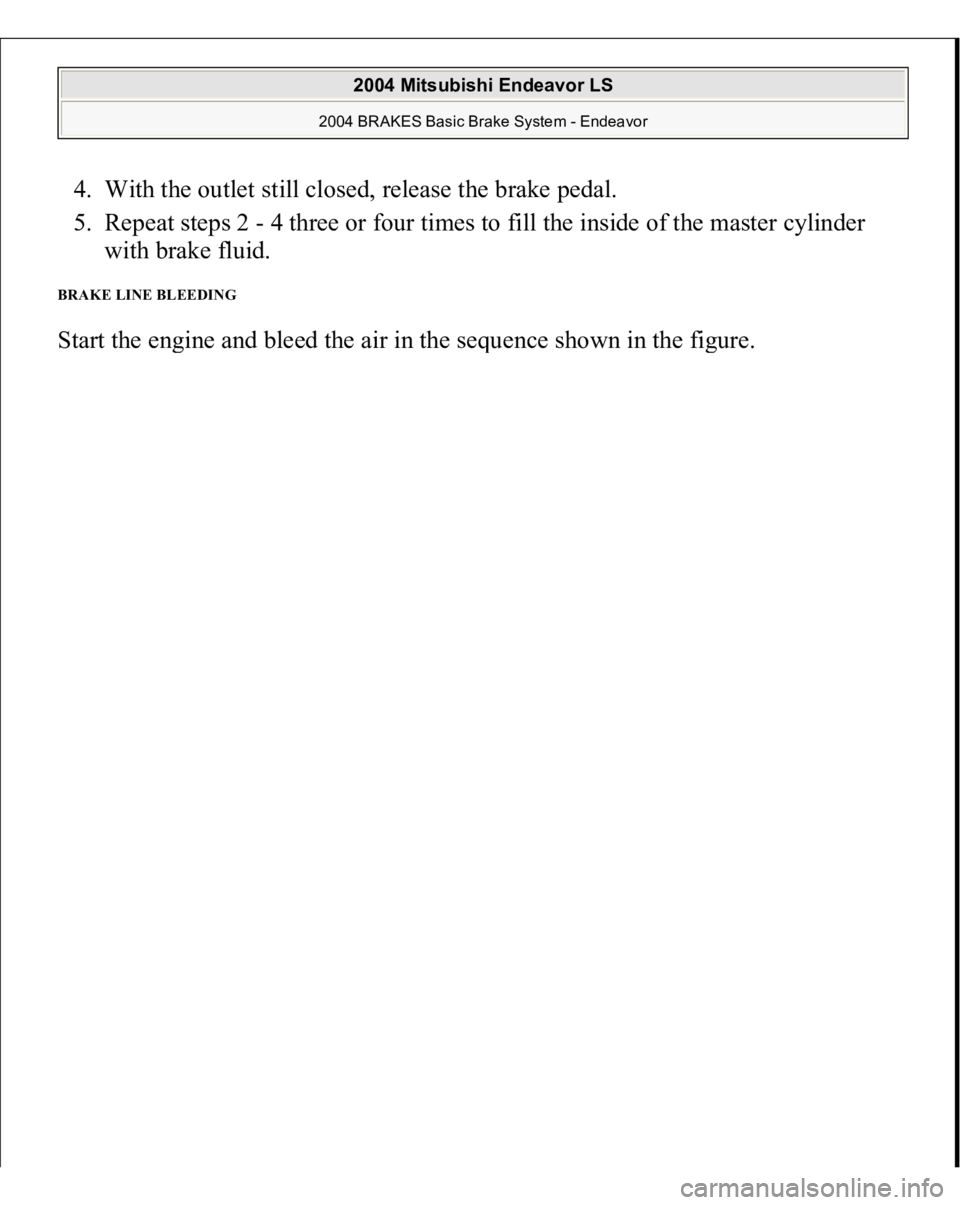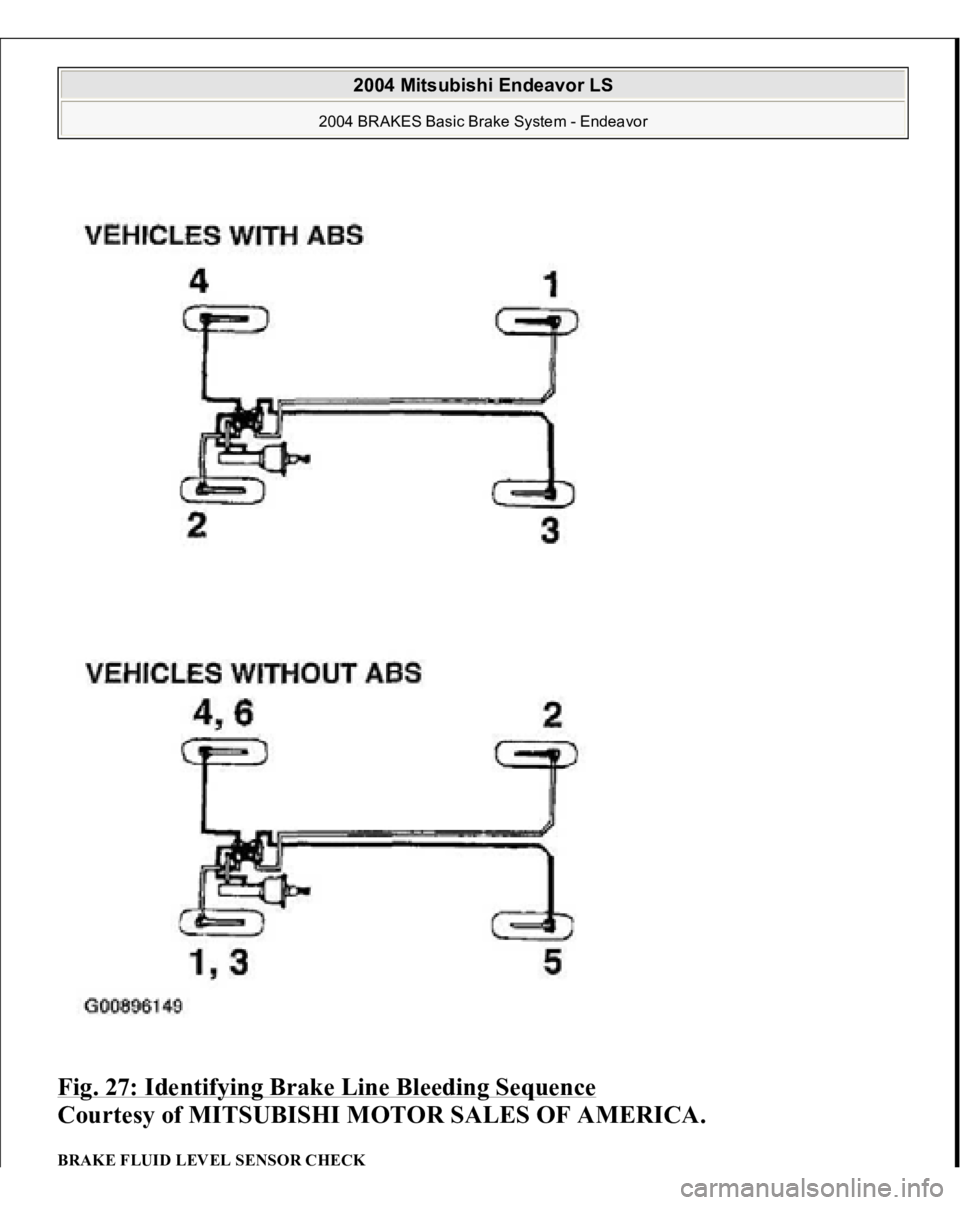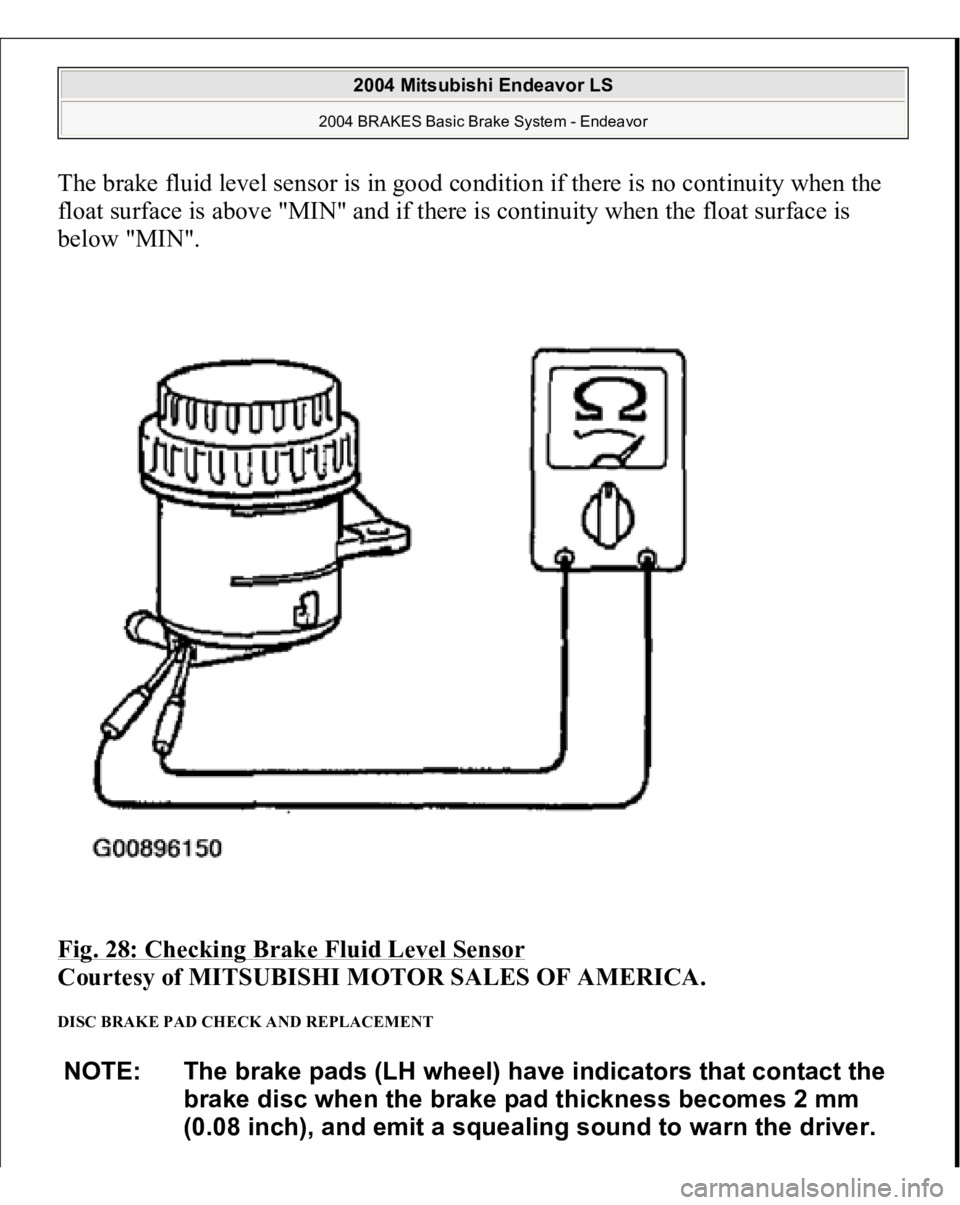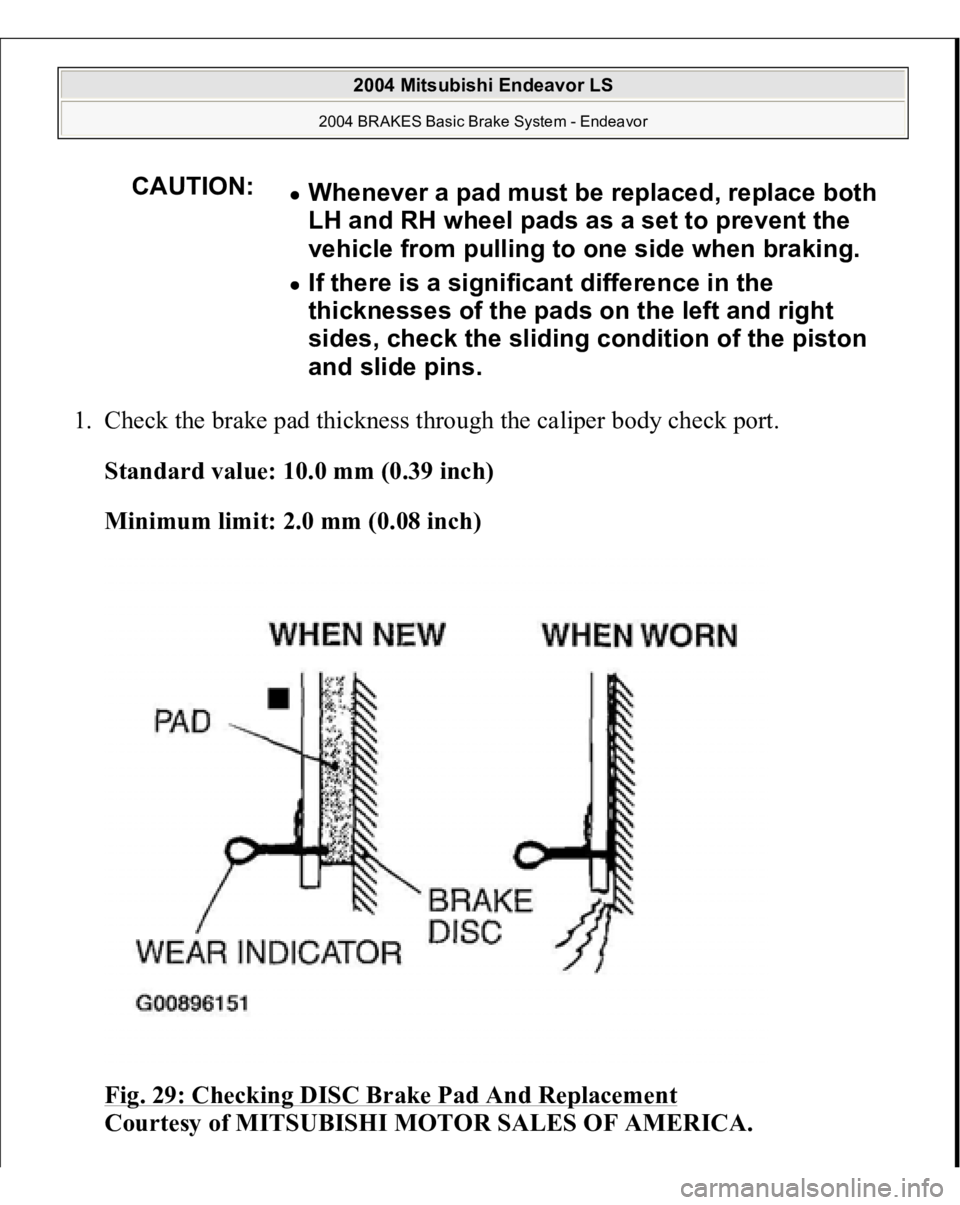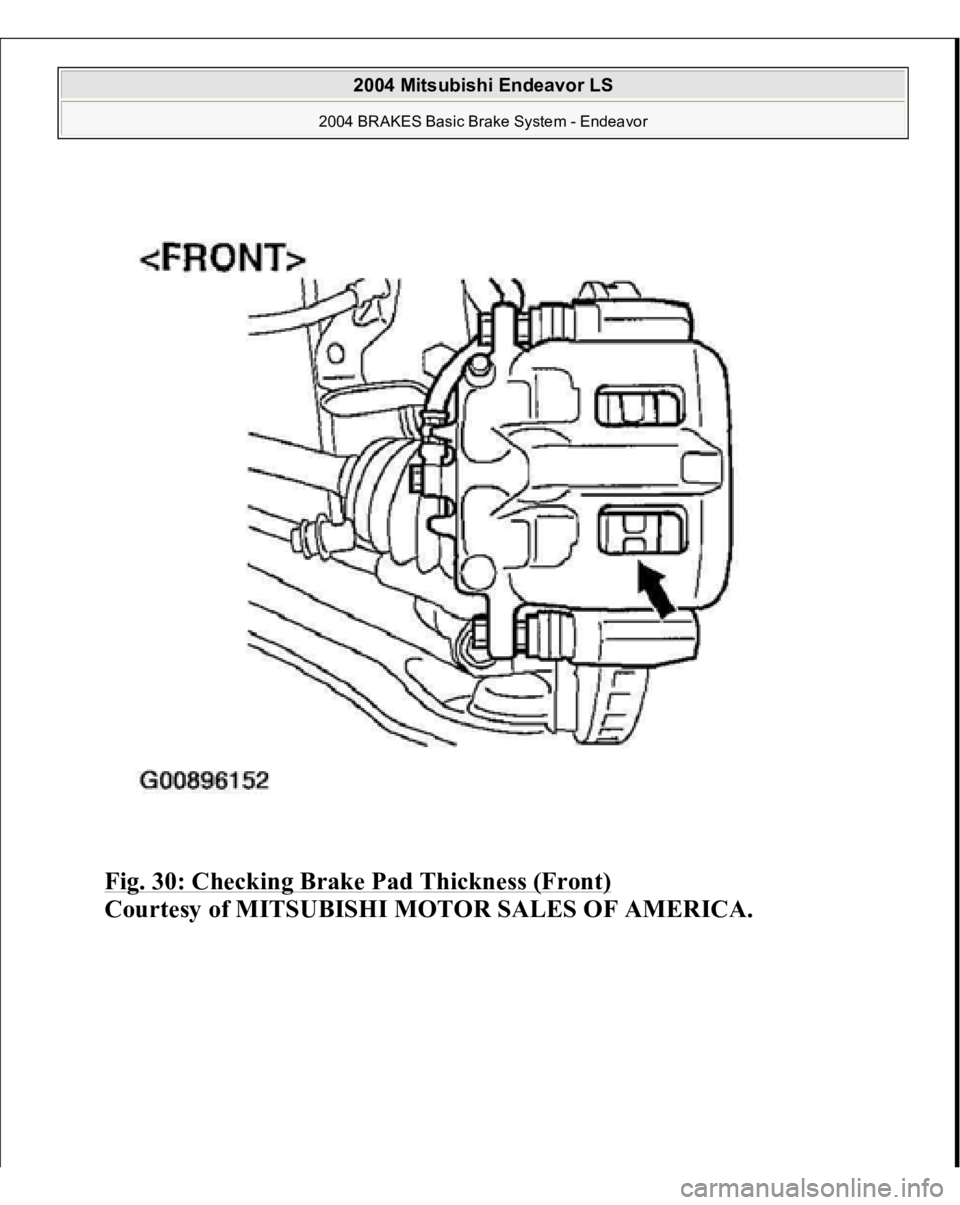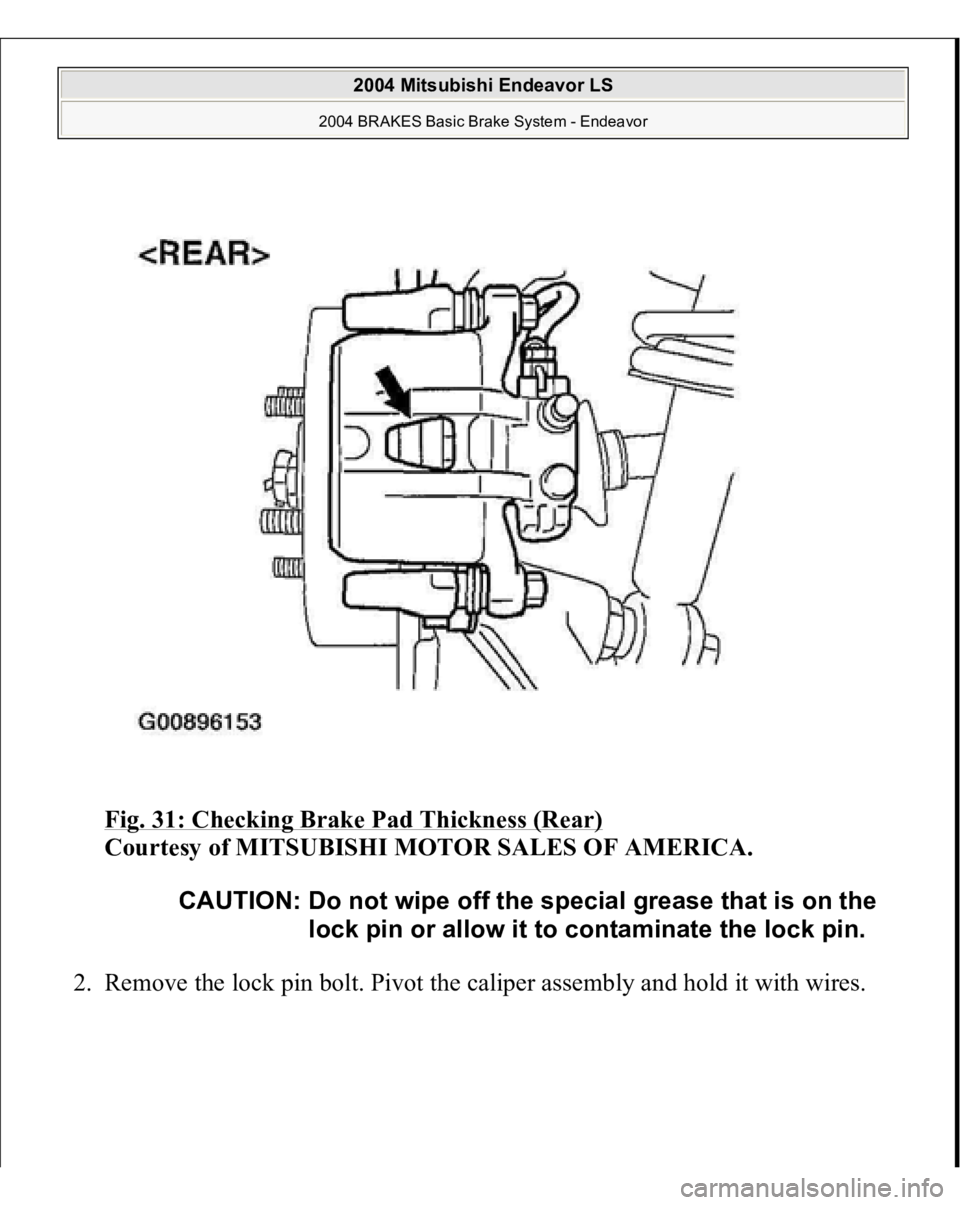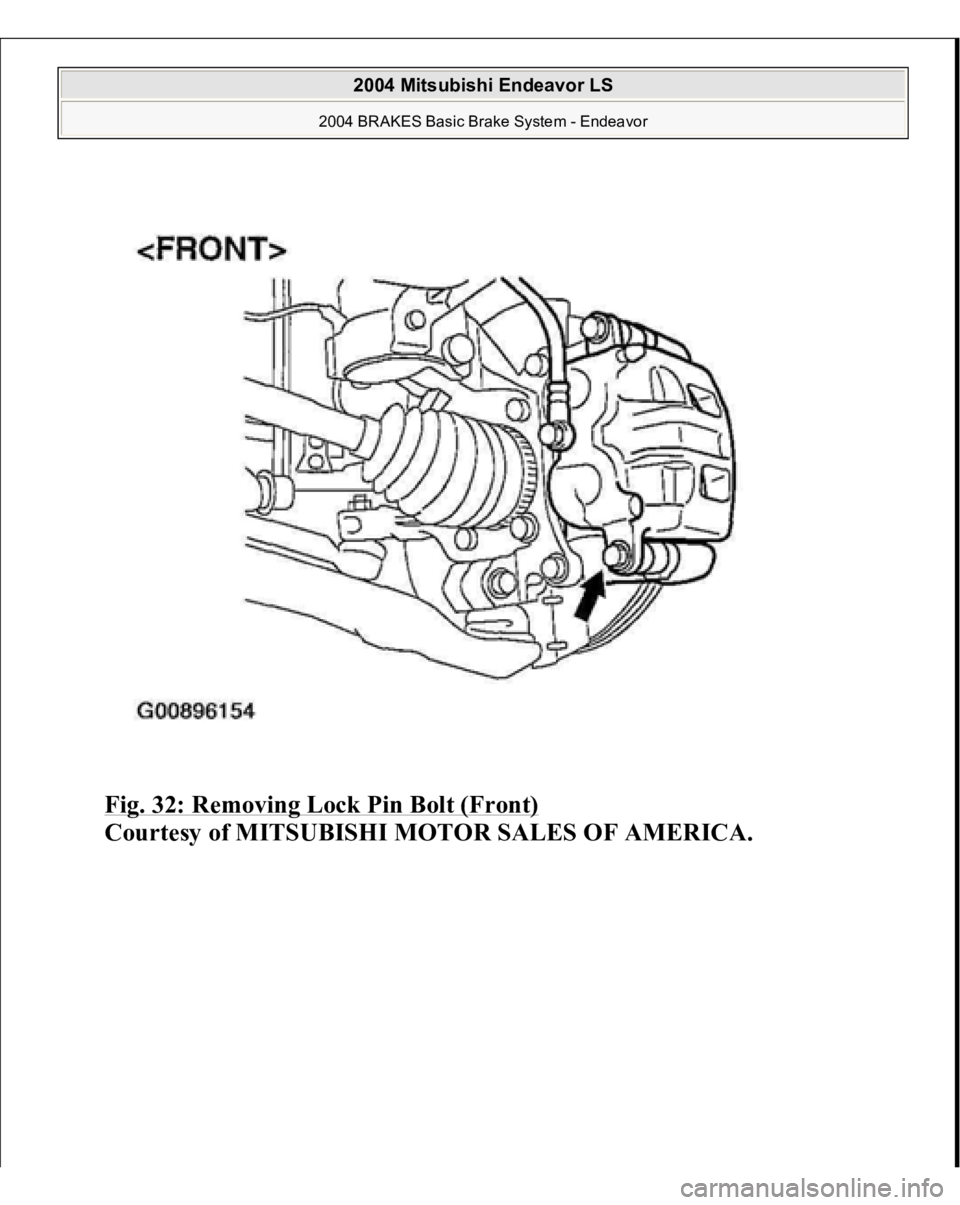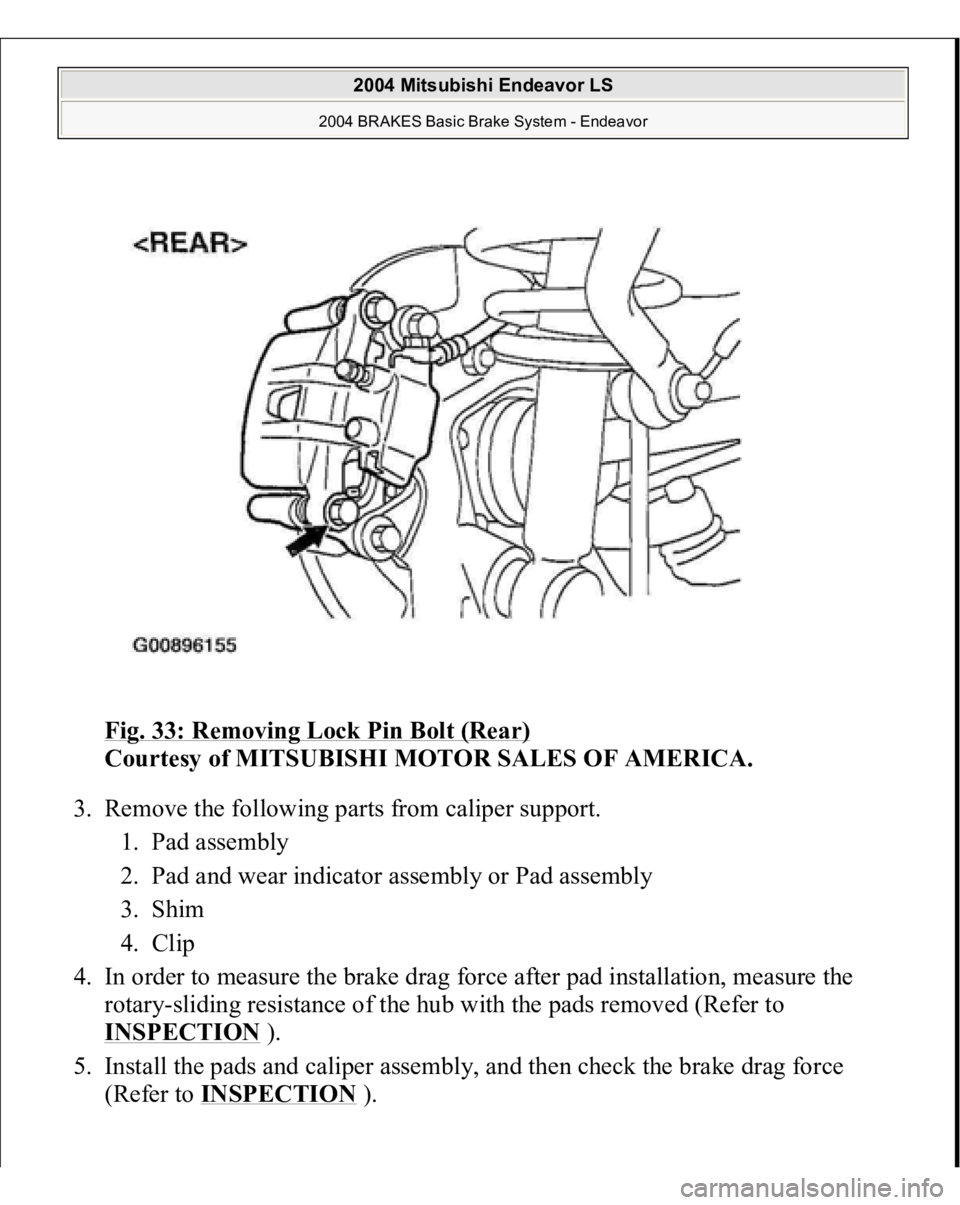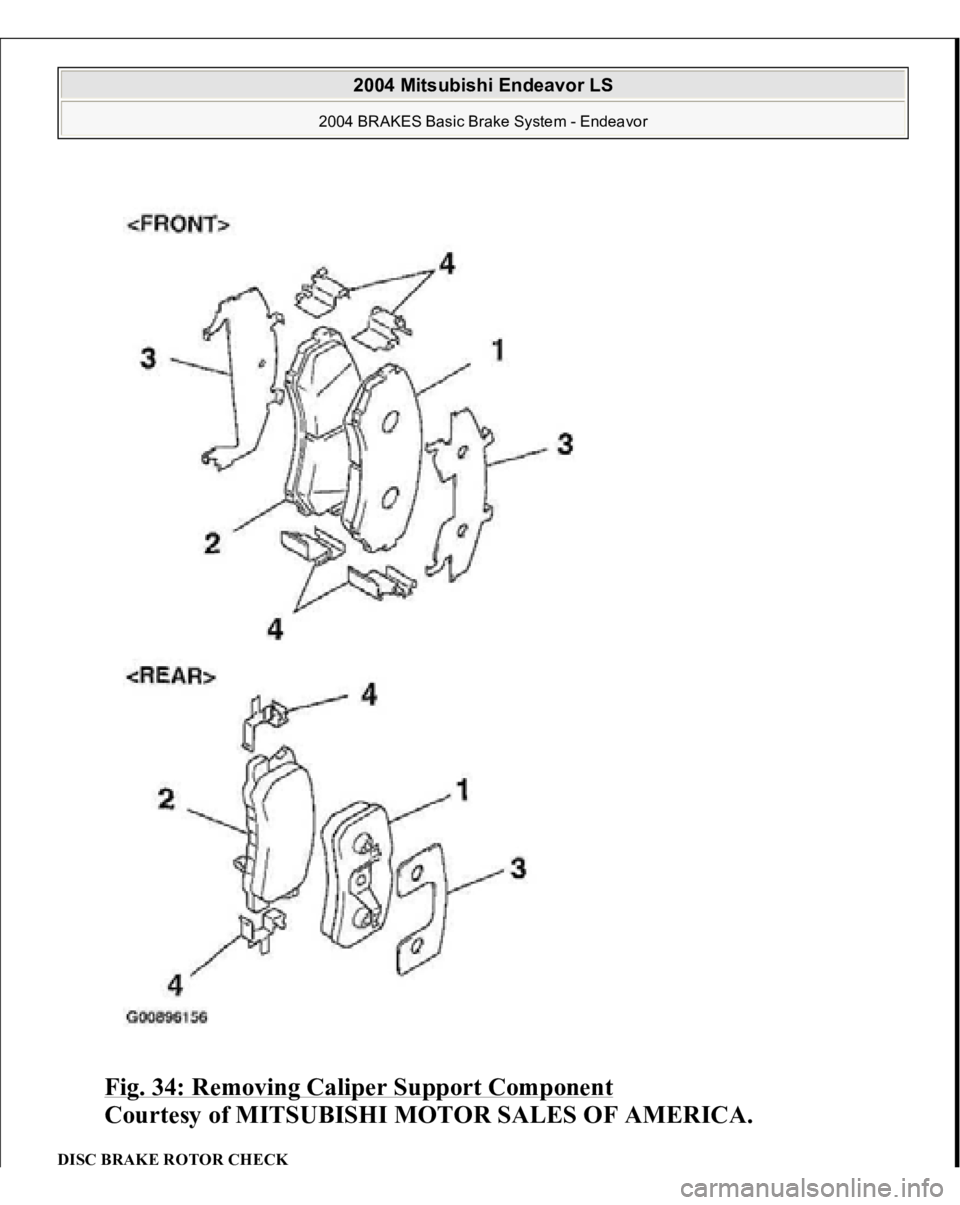MITSUBISHI ENDEAVOR 2004 Service Repair Manual
ENDEAVOR 2004
MITSUBISHI
MITSUBISHI
https://www.carmanualsonline.info/img/19/57105/w960_57105-0.png
MITSUBISHI ENDEAVOR 2004 Service Repair Manual
Trending: belt, ad blue, caution lights, USB, trailer, tailgate, set clock
Page 741 of 3870
The master cylinder used has no check valve, so if bleeding is carried out by the
following procedure, bleeding of air from the brake pipeline will become easier.
(When brake fluid is not contained in the master cylinder).
1. Fill the reserve tank with brake fluid.
2. Keep the brake pedal depressed.
3. Have another person cover the master cylinder outlet with a finger.
Fig. 26: Identifying Master Cylinder Outlet
Courtesy of MITSUBISHI MOTOR SALES OF AMERICA.
2004 Mitsubishi Endeavor LS
2004 BRAKES Basic Brake System - Endeavor
Page 742 of 3870
4. With the outlet still closed, release the brake pedal.
5. Repeat steps 2 - 4 three or four times to fill the inside of the master cylinder
with brake fluid. BRAKE LINE BLEEDING Start the en
gine and bleed the air in the se
quence shown in the fi
gure.
2004 Mitsubishi Endeavor LS
2004 BRAKES Basic Brake System - Endeavor
Page 743 of 3870
Fig. 27: Identifying Brake Line Bleeding Sequence
Courtesy of MITSUBISHI MOTOR SALES OF AMERICA.
BRAKE FLUID LEVEL SENSOR CHECK
2004 Mitsubishi Endeavor LS
2004 BRAKES Basic Brake System - Endeavor
Page 744 of 3870
The brake fluid level sensor is in good condition if there is no continuity when the
float surface is above "MIN" and if there is continuity when the float surface is
below "MIN".
Fig. 28: Checking Brake Fluid Level Sensor
Courtesy of MITSUBISHI MOTOR SALES OF AMERICA.
DISC BRAKE PAD CHECK AND REPLACEMENT NOTE: The brake pads (LH wheel) have indicators that contact the
brake disc when the brake pad thickness becomes 2 mm
(0.08 inch), and emit a squealing sound to warn the driver.
2004 Mitsubishi Endeavor LS
2004 BRAKES Basic Brake System - Endeavor
Page 745 of 3870
1. Check the brake pad thickness through the caliper body check port.
Standard value: 10.0 mm (0.39 inch)
Minimum limit: 2.0 mm (0.08 inch)
Fig. 29: Checking DISC Brake Pad And Replacement
Courtesy of MITSUBISHI MOTOR SALES OF AMERICA.
CAUTION:
Whenever a pad must be replaced, replace both
LH and RH wheel pads as a set to prevent the
vehicle from pulling to one side when braking. If there is a significant difference in the
thicknesses of the pads on the left and right
sides, check the sliding condition of the piston
and slide pins.
2004 Mitsubishi Endeavor LS
2004 BRAKES Basic Brake System - Endeavor
Page 746 of 3870
Fig. 30: Checking Brake Pad Thickness (Front)
Courtesy of MITSUBISHI MOTOR SALES OF AMERICA.
2004 Mitsubishi Endeavor LS
2004 BRAKES Basic Brake System - Endeavor
Page 747 of 3870
Fig. 31: Checking Brake Pad Thickness (Rear)
Courtesy of MITSUBISHI MOTOR SALES OF AMERICA.
2. Remove the lock pin bolt. Pivot the caliper assembly and hold it with wires.
CAUTION: Do not wipe off the special grease that is on the
lock pin or allow it to contaminate the lock pin.
2004 Mitsubishi Endeavor LS
2004 BRAKES Basic Brake System - Endeavor
Page 748 of 3870
Fig. 32: Removing Lock Pin Bolt (Front)
Courtesy of MITSUBISHI MOTOR SALES OF AMERICA.
2004 Mitsubishi Endeavor LS
2004 BRAKES Basic Brake System - Endeavor
Page 749 of 3870
Fig. 33: Removing Lock Pin Bolt (Rear)
Courtesy of MITSUBISHI MOTOR SALES OF AMERICA.
3. Remove the following parts from caliper support.
1. Pad assembly
2. Pad and wear indicator assembly or Pad assembly
3. Shim
4. Clip
4. In order to measure the brake drag force after pad installation, measure the
rotary-sliding resistance of the hub with the pads removed (Refer to
INSPECTION
).
5. Install the pads and caliper assembly, and then check the brake drag force
(Refer to INSPECTION
).
2004 Mitsubishi Endeavor LS
2004 BRAKES Basic Brake System - Endeavor
Page 750 of 3870
Fig. 34: Removing Caliper Support Component
Courtesy of MITSUBISHI MOTOR SALES OF AMERICA.
DISC BRAKE ROTOR CHECK
2004 Mitsubishi Endeavor LS
2004 BRAKES Basic Brake System - Endeavor
Trending: heater, service reset, four wheel drive, drain bolt, maintenance schedule, tailgate, parking brake
